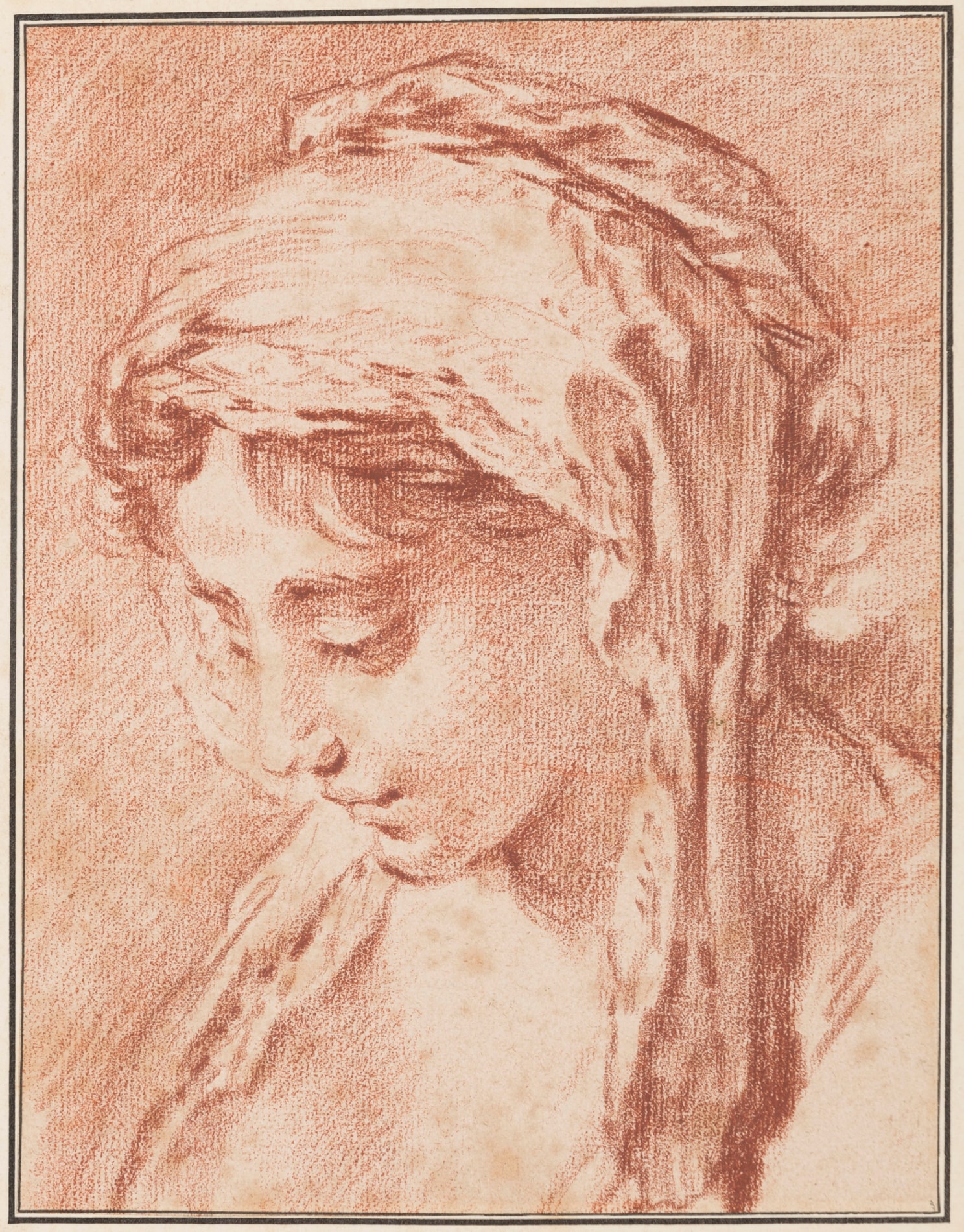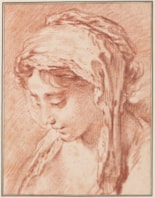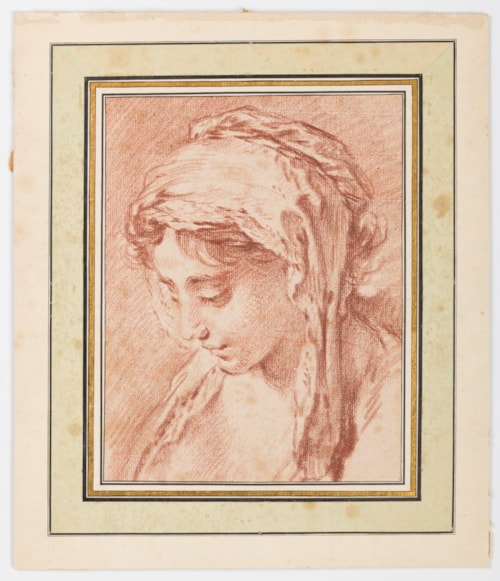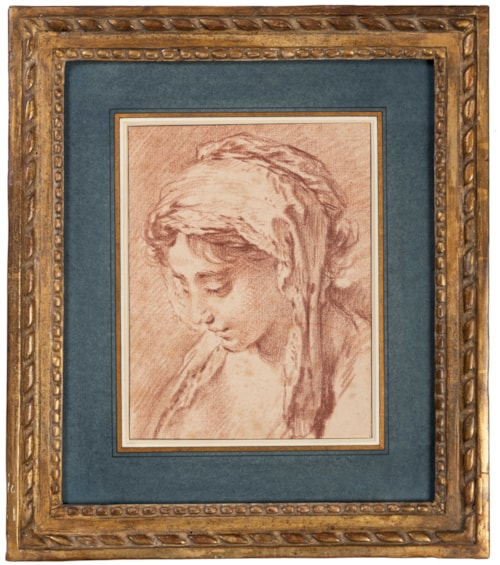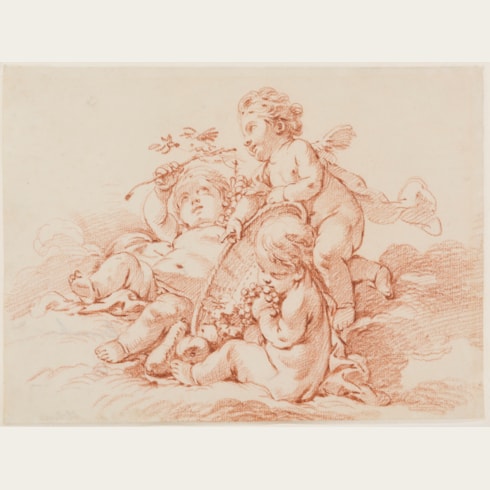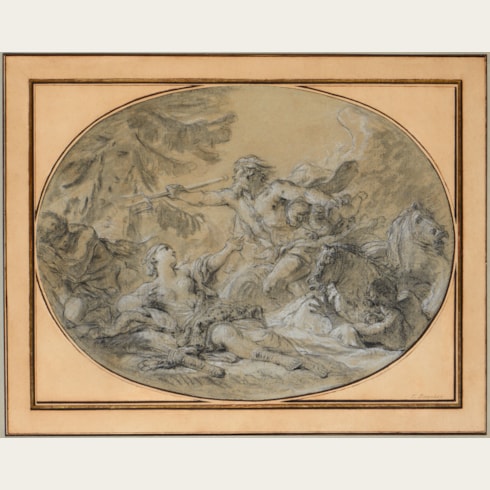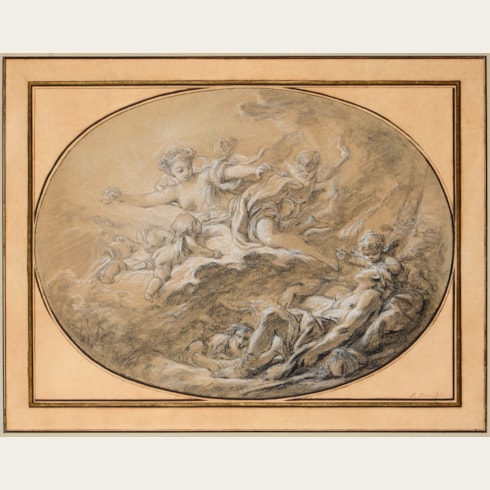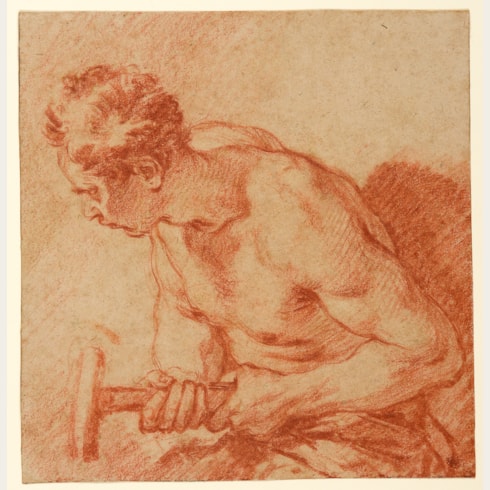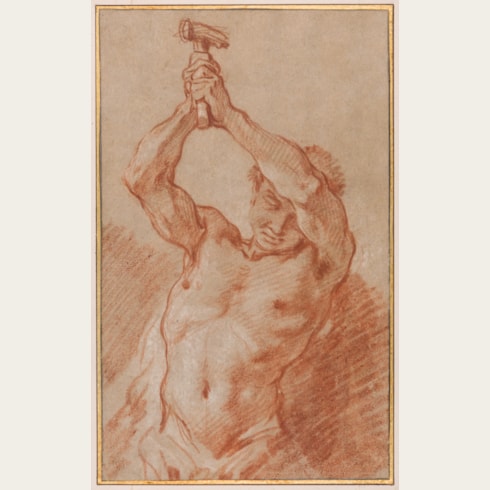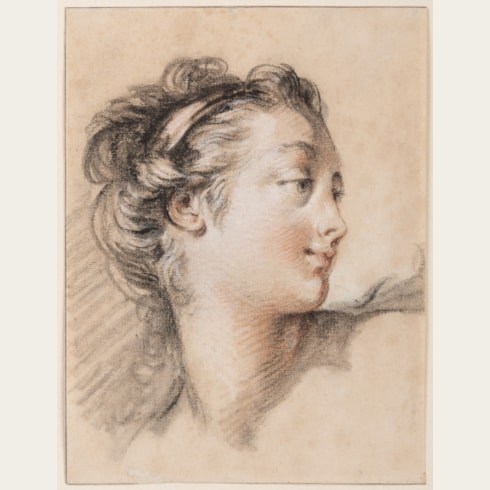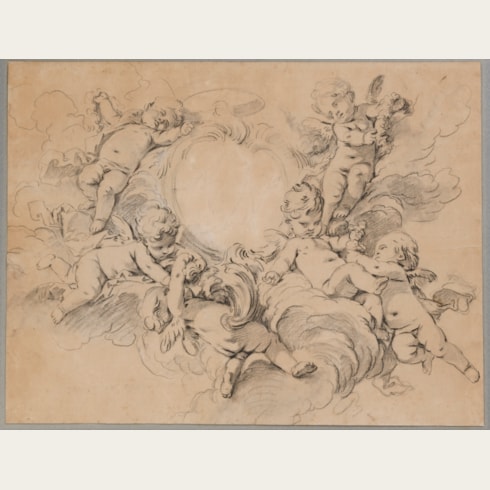François BOUCHER
(Paris 1703 - Paris 1770)
The Head of a Young Woman with a Headscarf, Looking Down to the Left
Laid down on a late 18th or 19th century French mount.
230 x 178 mm. (9 x 7 in.)
The present sheet was, in fact, used as the model for two different prints. It was reproduced, in reverse, in an etching by Jacques Gabriel Huquier the Younger (1725-1805), while another print after the same drawing – a red-chalk manner engraving in the same direction as the present sheet, but with the composition extended at the bottom so as to depict a three-quarter length figure – was published by Gilles Demarteau (1722-1776), a printmaker who specialized in this type of coloured engraving.
When this drawing was included in an exhibition of paintings and drawings by François Boucher from private collections, held at the Musée Lambinet in Versailles in 2004, the Boucher scholar Françoise Joulie wrote of it at length: ‘Wearing a lace headscarf, the transparency of which is suggested by the white reserve of the paper, this woman in profile could not have been done before the 1760s. The red chalk chosen by the artist is that of his later years, ever darker and darker; it is treated extensively to suggest the folds of the kerchief falling over the throat or the curls of hair escaping from the headdress, finely hatched over the cheek to give it volume and suggest the roundness of this part of the face in shadow; on the other hand, it is used with precision to emphasise the crease of the lip and to detail one by one the eyelashes shading the eyes, in a process characteristic of the artist’s maturity. The face stands out against a background of sober hatching, which Boucher was able to interrupt on the left-hand side of the sheet to show the light fabric running down the cheek; in so doing, he suggested a volume that the light illuminating the nape of his model’s neck confirms. The drawing is lit from the top left-hand corner, so that the top of the kerchief and the rounded forehead are left white, while the chin casts its shadow over the neck. This masterly illumination, the young woman’s pensive smile and the secrecy of a gaze that turns away give this seemingly simple head study, engraved by Demarteau and Huquier, a profound inner life.’
The late Boucher scholar Alastair Laing noted an analogy between the present sheet, as reproduced in prints by Huquier fils and Demarteau, and the head of the kitchen maid in Boucher’s small painting La belle cuisinière (The Beautiful Kitchen Maid), datable to c.1733-1734, in the collection of the Musée Cognac-Jay in Paris8. However, as he noted, in the drawing the head is ‘studied at a slightly different angle and in a more elaborate kerchief’ than in the painting.
According to the caption on the red-chalk manner engraving after this drawing by Gilles Demarteau, the first owner of the present sheet was Charles Marin de La Haye des Fossés (1736-1790), fermier general du roi and adminstrateur des postes de France. Marin de la Haye was one of a number of contemporary collectors who acquired drawings by Boucher, and he may have been encouraged to do so by his older sister, Catherine-Charlotte-Edmée de la Haye des Fossés, and her husband, Barthelémy-Augustin Blondel d’Azaincourt, who between them assembled a group of several hundred drawings by the artist. Marin de la Haye’s wife, Marie Adélaïde Victoire Bouret, also owned a number of drawings by Boucher, while another of his sisters was married to Jean-François Bergeret de Frouville, likewise a patron of Boucher and the younger brother of one of the artist’s greatest patrons and collectors, Pierre-Jacques-Onésyme Bergeret de Grancourt. As Alastair Laing has pointed out, ‘The four members of the de la Haye and Blondel d’Azaincourt families were thus not only between them the major collectors of Boucher’s drawings - Blondel d’Azaincourt was said in 1766 to have owned almost 500 of them – and particularly of those that they lent to be engraved as chalk-manner prints, but they were also thus linked to two of Boucher’s major patrons for paintings in the latter part of his life, Bergeret de Grancourt…and Bergeret de Frouville.’
Laing has further noted that, ‘In the case of the major makers and publishers of chalk-manner engravings, Gilles Demarteau the Elder and Louis-Marin Bonnet, their procurement of drawings to be engraved fed directly off [another] factor encouraging Boucher’s production of autonomous drawings: the rise of the dedicated collector…in the case of Bonnet and Demarteau many of their prints of Boucher’s drawings…specifically proclaim themselves as done after originals in the cabinet, or collection, of particular collectors. Evidently, in the case of certain collectors of Boucher’s drawings, it was not enough to enjoy the possession of them; their publication also boosted the reputation of their owner as a true connoisseur.’ Marin de la Haye owned at least thirty-five drawings by Boucher that were reproduced as engravings, while his wife owned a further three.
Appointed a professor at the Académie Royale in 1735, Boucher painted numerous easel pictures – pastoral landscapes, religious and mythological subjects, genre scenes, chinoiseries and portraits – for private clients in France, Sweden, Denmark, Germany and Poland, while also producing several tapestry cartoons for the Beauvais and Gobelins manufactories, where he succeeded Jean-Baptiste Oudry as inspecteur des ouvrages in 1755. He designed stage sets and costumes for the Opéra and the Opéra-Comique in the 1740s and created designs for Vincennes and later Sèvres porcelain throughout the 1750s and early 1760s. In 1765 Boucher was named premier peintre du roi, or First Painter to the King, and also appointed director of the Académie Royale. In 1770 he died at his lodgings in the Louvre and was buried in the church of Saint-Germain l’Auxerrois. Among his pupils were Jean-Baptiste Deshays and Pierre-Antoine Baudouin, both of whom became his sons-in-law and predeceased him, as well as Jean-Honoré Fragonard, Jean-Baptiste Le Prince and Gabriel-Jacques de Saint-Aubin.
A gifted draughtsman, François Boucher was as prolific as he was talented, and claimed to have produced ten thousand drawings over a career that lasted some fifty years. He was, in fact, perhaps the most prolific French draughtsman of the eighteenth century, and his drawn oeuvre includes pastoral scenes, nudes, religious, historical and mythological subjects, book illustrations, chinoiseries, landscapes, genre scenes, studies of children and heads, as well as designs for tapestries, porcelain and fountains. Although most of his drawings were preparatory studies for his paintings, Boucher also produced finished drawings as independent works, often adapting and elaborating a head or figure from one of his paintings. While his preference was for black, red, and (particularly in his later years) a dark brown chalk, he also made highly finished drawings in pastel and, at times, drew on coloured paper. As Pierre Rosenberg has succinctly noted, ‘Boucher’s love of drawing never waned with time and success. Admittedly, drawing was kept in its proper place, as a vital link between the conception or the idea of a work or composition, and its realization, its metamorphosis into a painting…To quote Mariette, Boucher “was a born painter”, but he placed great emphasis on drawing throughout his entire career.’ Boucher’s drawings were avidly collected in his lifetime by such connoisseurs as Barthelémy-Augustin Blondel d’Azaincourt, Paul Randon de Boisset, Pierre-Jacques-Onésyme Bergeret de Grancourt, Gilbert Paignon-Dijonval, Jean-Claude Gaspard de Sireuil, Count Carl Gustaf Tessin, and many others.
Boucher's drawn oeuvre includes all manner of subjects, including pastoral scenes, nudes, religious, historical and mythological subjects, book illustrations, chinoiseries, landscapes, nudes, genre scenes, studies of children and heads, as well as designs for tapestries, porcelain and fountains. He produced many finished drawings as independent works, often adapting and elaborating a head or figure from one of his paintings. While his preference was for black, red, and (particularly in his later years) brown chalk, Boucher also made highly finished drawings in pastel and, at times, drew on coloured paper. A large number of his drawings were finished works for collectors and the art market, and many were engraved and reproduced in considerable numbers – often making use of new printmaking techniques that allowed chalk drawings to be reproduced with a high degree of verisimilitude - by such printmakers as Louis-Marin Bonnet, Gilles Demarteau or Gabriel Huquier. His drawings were greatly admired, and while many were preparatory studies for his paintings, others were produced as finished works of art, to be sold to collectors or reproduced by engravers. Indeed, Boucher’s popularity as a draughtsman owes much to the fact that many of his drawings were reproduced and widely distributed as engravings.
Provenance
[François Roman?], Marquis d’Amat
Grawert collection, Frankfurt
Private collection.
Literature
Exhibition

